Yamaha YZF-R125 Service Manual: Measuring the compression pressure
NOTE:
Insufficient compression pressure will result in a loss of performance.
1. Measure:
Valve clearance Out of specification →Adjust.
Refer to "ADJUSTING THE VALVE CLEARANCE" on page 3-3.
2. Start the engine, warm it up for several minutes, and then turn it off.
3. Remove:
- Rider seat
- Right upper side cowling Refer to "GENERAL CHASSIS" on page 4-1.
4. Remove:
- Fuel tank Refer to "FUEL TANK" on page 7-1.
5. Disconnect:
- Coolant temperature sensor coupler "1"
- Spark plug cap "2"
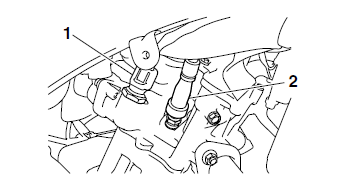
6. Remove:
- Spark plug
| CAUTION: Before removing the spark plug, use compressed air to blow away any dirt accumulated in the spark plug well to prevent it from falling into the cylinder. |
7. Install:
- Extension "1"
- Compression gauge "2"
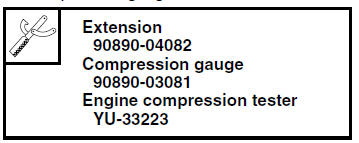
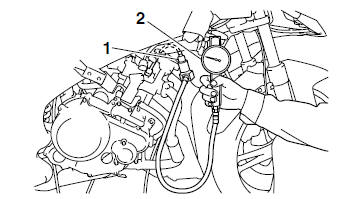
8. Measure:
- Compression pressure
Out of specification Refer to steps (c) and
(d).
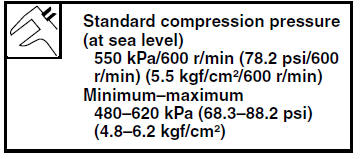
a. Set the main switch to "ON".
b. With the throttle wide open, crank the engine until the reading on the compression gauge stabilizes.
c. If the compression pressure is above the maximum specification, check the cylinder head, valve surfaces and piston crown for carbon deposits.
Carbon deposits Eliminate.
d. If the compression pressure is below the minimum specification, pour a teaspoonful of engine oil into the spark plug bore and measure again.
Refer to the following table.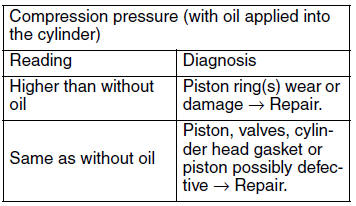
9. Remove:
- Extension
- Compression gauge
10.Install:
- Spark plug

11.Connect:
- Spark plug cap
- Coolant temperature sensor coupler
12.Install:
- Fuel tank Refer to "FUEL TANK" on page 7-1.
13.Install:
- Right upper side cowling
- Rider seat Refer to "GENERAL CHASSIS" on page 4-1.
 Checking the ignition timing
Checking the ignition timing
NOTE:
Prior to checking the ignition timing, check the
wiring connections of the entire ignition system.
Make sure all connections are tight and free of
corrosion.
1. Remove:
Rider seat
L ...
 Checking the engine oil level
Checking the engine oil level
1. Stand the vehicle on a level surface.
NOTE:
Place the vehicle on a suitable stand.
Make sure the vehicle is upright.
2. Start the engine, warm it up for several minutes,
and then turn it ...
Other materials:
Checking the spark plug cap
1. Check:
Spark plug cap resistance
Out of specification Replace.
a. Remove the spark plug cap from the spark
plug lead.
b. Connect the pocket tester ( × 1k)
to the
spark plug cap as shown.
c. Measure the spark plug cap resistance. ...
Sidestand
The sidestand is located on the left side
of the frame. Raise the sidestand or
lower it with your foot while holding the
vehicle upright.
TIP
The built-in sidestand switch is part of
the ignition circuit cut-off system, which
cuts the ignition in certain situations.
WARNING
The vehicl ...
Installing the rear wheel (disc)
1. Install:
Rear brake disc
NOTE:
Tighten the brake disc bolts in stages and in a
crisscross pattern.
2. Check:
Rear brake disc
Refer to "CHECKING THE REAR BRAKE
DISC" on page 4-33.
3. Lubricate:
Rear wheel axle
Contact surface of rear wheel hub and rear
wheel
Whee ...
